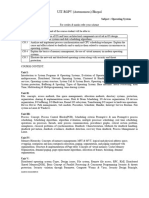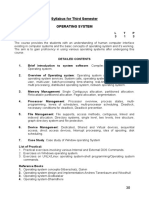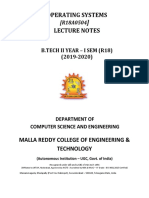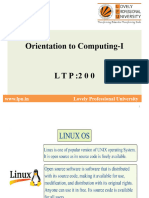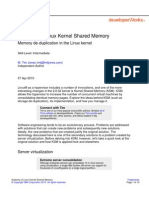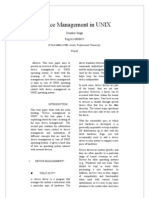W.E.F Academic Year 2012-13 G' Scheme
W.E.F Academic Year 2012-13 G' Scheme
Uploaded by
avani292005Copyright:
Available Formats
W.E.F Academic Year 2012-13 G' Scheme
W.E.F Academic Year 2012-13 G' Scheme
Uploaded by
avani292005Original Title
Copyright
Available Formats
Share this document
Did you find this document useful?
Is this content inappropriate?
Copyright:
Available Formats
W.E.F Academic Year 2012-13 G' Scheme
W.E.F Academic Year 2012-13 G' Scheme
Uploaded by
avani292005Copyright:
Available Formats
w.e.
f Academic Year 2012-13 ‘G’ Scheme
Course Name : Computer Engineering Group
Course Code : CO/CD/CM/CW/IF
Semester : Fifth for CO/CM/IF/CW and Sixth for CD
Subject Title : Operating System
Subject Code : 17512
Teaching and Examination Scheme:
Teaching Scheme Examination Scheme
PAPER
TH TU PR TH PR OR TW TOTAL
HRS
03 -- 02 03 100 -- -- 25@ 125
NOTE:
Two tests each of 25 marks to be conducted as per the schedule given by MSBTE.
Total of tests marks for all theory subjects are to be converted out of 50 and to be
entered in mark sheet under the head Sessional Work (SW).
Rationale:
Operating system is the software that makes a computers system operational. It is an
interface between the human and machine. It drives all the hardware parts of the computer and is
the first piece of software to run on the machine when the system boots.
OS is a core technology subject, the knowledge of which is mandatory for every user. If
familiarizes a learner with the OS concepts, structure internal functionality and services and
resource sharing. It will help a learner with OS design concepts. This subject will give a learner an
overview of UNIX / LINUX OS.
General Objectives:
To develop following skills:
Intellectual skills:
1. Learn the various milestones in the history of Operating Systems and various Generations
of computers as well as the modern trends in Operating Systems.
2. Understand the kernel architectures, the functions of operating systems and the use of
system calls.
3. Understand the concept of processes, multiprogramming, Process Control Blocks, context
switching.
4. Learn about the scheduler and implement various scheduling algorithms.
5. Understand about Deadlocks, Inter-process communications.
6. Learn about Memory Management and File Management techniques of the OS.
7. Understand the structure and file system structure of Unix OS.
8. Use UNIX commands, vi editor and file utilities and write shell scripts.
MSBTE – Updated On 20/06/2014 2 17512 CO5
w.e.f Academic Year 2012-13 ‘G’ Scheme
Contents: Theory
Topic
Contents Hours Marks
No.
Introduction:
Objectives:
Distinguish between various generation of computer.
Classify different types of operating system.
01 04 12
1.1 Operating System - Evaluation, Generations 1st, 2nd, 3rd
1.2 Different Types of Operating systems- Batch operating system,
Multi Programmed, Multitasking, Time Shared OS. Multiprocessor
Systems, Distributed Systems, Cluster Systems, Real time systems.
Operating System Structures:
Objectives:
State services & functions of Operating Systems.
Use system calls
Distinguish between different kernel architecture.
02 2.1 Different Services of Operating System. 08 18
2.2 System Calls- Concept, Types and Uses
2.3 Simple Structure, Layered, Monolithic, Microkernel.
2.4 Components activities- Process Management, Main Memory
Management, File Management, I/O System management,
Secondary storage management.
Process Management :
Objectives:
Describe Process, process scheduling, schedulers.
Describe inter-process communication & synchronization.
Describe critical section problem & solution to ensure the
consistency of shared data
Describe multithreading models.
03 10 22
3.1 Process-Concept, process states, Process Control Block.
3.2 Process Scheduling- Scheduling Queues, Schedulers, Context
switch.
3.3 Inter-process communication- Introduction, shared memory system
& message passing system, critical section problem, semaphores.
3.4 Threads - Benefits, users and kernel threads, Multithreading Models
- Many to One, One to One, Many to Many.
Scheduling :
Objectives:
Describe CPU scheduling.
Describe various CPU-scheduling algorithms.
Solve problems based on them.
Describe deadlock and its algorithm.
4.1 Scheduling & its types - Objectives, concept, CPU and I/O burst
04 cycles, Pre-emptive, Non- Pre-emptive Scheduling, Scheduling 10 20
criteria.
4.2 Types of Scheduling algorithms - First come first served (FCFS),
Shortest Job First (SJF), Shortest Remaining Time(SRTN), Round
Robin (RR) Priority scheduling, multilevel queue scheduling
4.3 Deadlock - System Models, Necessary Conditions leading to
Deadlocks, Deadlock Handling - Preventions, avoidance, Banker’s
algorithm
MSBTE – Updated On 20/06/2014 3 17512 CO5
w.e.f Academic Year 2012-13 ‘G’ Scheme
File System and Memory Management :
Objectives:
Distinguish between memory allocation methods
Distinguish between various file access methods.
Describe files, file attributes and file structure.
5.1 Basic Memory Management - Partitioning, Fixed and Variable,
Free Space management Techniques - Bitmap, Linked List.
05 10 20
5.2 Virtual Memory – Concept, Segmentation, Paging, Page table, Page
fault.
5.3 File – Concepts, Attributes Operations, Types, and File System
Structure.
5.4 Access Methods – Sequential, Direct, Swapping, File Allocation
Methods- Contiguous, Linked, Indexed.
5.5 Directory Structure – Single level, Two levels.
UNIX : A Case Study
Objectives:
Draw system structure and file system structure of UNIX
06 06 08
Distinguish between UNIX and LINUX system
Introduction, Overview of UNIX, Structure of UNIX OS, Booting, File
System Of UNIX, UNIX and LINUX Comparison.
Total 48 100
List of Practical:
Sr. No. Title of Experiment No. of Hours
1 Differentiate between various Operating System 02
Use of file processing and Communication command – tr, wc, cut,
2 02
paste, sort
Use of file processing and Communication command- who, who am I,
3 02
mesg, talk, wall, write, news, mail.
Use of general purpose and process commands- date, time, cal, clear,
4 02
banner
Use of general purpose and process commands- , tty, man, bc, ps, wait,
5 02
sleep, exit, kill.
Work with file and directory commands viz, pwd, cat, ls, cd, mkdir,
6 02
rmdir, rm, mv
Work with file and directory commands viz cp, join, split, head, tail,
7 02
omm., pr, chmod, cmp.
8 Use of vi editor and editor commands 04
Write and execute menu driven shell scripts using case structures(any
9 02
two)
10 Write and program to implement the Shortest Job First algorithm. 04
11 Write and program to implement the Priority scheduling algorithm. 04
12 Write and program to implement the Round-Robin algorithm. 04
**Students can perform any ten practical
MSBTE – Updated On 20/06/2014 4 17512 CO5
w.e.f Academic Year 2012-13 ‘G’ Scheme
Learning Recourses:
1. Books:
Sr. No Book Title Author Publication
Operating System Concepts-
01 Silberschatz Galvin John Wiley and Sons
VIIIth Edition
02 Operating System Achyut S. Godbole Tata McGraw Hill
03 Operating System William Stallings Pearson
rd
Andrew tanenbaum-3
04 Modern Operating systems PHI
edition
Unix Concept and
05 Sumitabha Das Tata McGraw Hill
Programming
06 UNIX Programming Kumar Saurabh Wiley India
2. Websites:
1. cs.wisc.edu/~ bart/537 lecture notes-University of Wisconsin Madison.
2. www.cs.kent.edu/osf o3/notes/index.html- Vilinius Gediminas Technical University
3. http://www.howstuffworks.com/operating-system1.htm
4. www.computerhope.com/jargon/o/os.htm
5. en.wikipedia.org/wiki/Operating system
Demo lectures with power point presentations using LCD projector should be arranged to develop
programming concepts of students.
MSBTE – Updated On 20/06/2014 5 17512 CO5
You might also like
- Vxworks Kernel Programmers Guide 6.9Document765 pagesVxworks Kernel Programmers Guide 6.9justnivasNo ratings yet
- Unit 1 Question and AnswerDocument5 pagesUnit 1 Question and AnswerSangam Maurya100% (1)
- Operating System 2 Marks and 16 Marks - AnswersDocument45 pagesOperating System 2 Marks and 16 Marks - AnswersDiana Arun75% (4)
- BTech - 5sem - CE - Booklet - 2022-23-ODDDocument37 pagesBTech - 5sem - CE - Booklet - 2022-23-ODDjay patelNo ratings yet
- MASTER OF COMPUTER APPLICATION (Two Year Course) MCA Ist Year 2020-21 Kca203: Operating SystemsDocument1 pageMASTER OF COMPUTER APPLICATION (Two Year Course) MCA Ist Year 2020-21 Kca203: Operating SystemsArun GurjarNo ratings yet
- Operating Digital Notes (R22 Regulation)Document156 pagesOperating Digital Notes (R22 Regulation)tejasriadavathNo ratings yet
- Annexure II Detailed Curriculum of Data SciencesDocument16 pagesAnnexure II Detailed Curriculum of Data SciencesAlthaf HussainNo ratings yet
- Csit r22 Operating SystemsDocument156 pagesCsit r22 Operating Systemsashok.202953No ratings yet
- HTTP - App - Utu.ac - in - Utuexmanagement - Exammsters - Syllabus - CE2010-Operating System1Document4 pagesHTTP - App - Utu.ac - in - Utuexmanagement - Exammsters - Syllabus - CE2010-Operating System1ꌩꍏꌗꃅꋪꍏꀭ T͡ᎻმƘ๏ԻNo ratings yet
- V Sem Syllabus 2020-21200121020338270921011611Document13 pagesV Sem Syllabus 2020-21200121020338270921011611Anmol SharmaNo ratings yet
- Operating System Concepts - 21BCA43 NEWDocument2 pagesOperating System Concepts - 21BCA43 NEWVaishnavi PatilNo ratings yet
- Operating SystemsDocument161 pagesOperating SystemsfortyNo ratings yet
- OS Odd23Document7 pagesOS Odd23hrajaa16No ratings yet
- 2022 - TBC 204 Operating SystemsDocument2 pages2022 - TBC 204 Operating SystemsDeepu RawatNo ratings yet
- Operating Systems NotesDocument135 pagesOperating Systems NotesSanthanalakshmi SelvakumarNo ratings yet
- Course Outline OS-TemplateDocument7 pagesCourse Outline OS-TemplateissisissNo ratings yet
- 2 Operating SystemsDocument174 pages2 Operating SystemsMohammad KhanNo ratings yet
- T.Y.B.sc. Computer Science 30juneDocument53 pagesT.Y.B.sc. Computer Science 30juneAshutosh MorwalNo ratings yet
- Os SyllabusDocument2 pagesOs Syllabusjijay94837No ratings yet
- AdministrationDocument4 pagesAdministrationSreekanth KuNo ratings yet
- COA Full Syllabus-CSEDocument3 pagesCOA Full Syllabus-CSEAMARTYA KUMARNo ratings yet
- Syllabus For Third Semester Operating SystemDocument10 pagesSyllabus For Third Semester Operating SystemMicNo ratings yet
- 0 Course OutlinesDocument3 pages0 Course Outlineskonainali046No ratings yet
- University of Mumbai University of Mumbai University of MumbaiDocument19 pagesUniversity of Mumbai University of Mumbai University of MumbaiJaya PillaiNo ratings yet
- SSZG 516Document5 pagesSSZG 516tejatejeswar6No ratings yet
- Dept. of Comp. Engg. Lecture Plan For CO24508 Operating Systems Course Instructor: Dr. Vandan TewariDocument4 pagesDept. of Comp. Engg. Lecture Plan For CO24508 Operating Systems Course Instructor: Dr. Vandan TewariSmit PatelNo ratings yet
- Diploma Semester V OSDocument4 pagesDiploma Semester V OSjatinnparmar52No ratings yet
- Digital Notes Operating Systems (R20a0504)Document161 pagesDigital Notes Operating Systems (R20a0504)Kalpana MrcetNo ratings yet
- Operating Systems Fall 24 25Document9 pagesOperating Systems Fall 24 25remonkumar21No ratings yet
- Operating System Exam NotesDocument95 pagesOperating System Exam Notesgowolo4077No ratings yet
- Operating System QuantumDocument85 pagesOperating System QuantumVarnika TomarNo ratings yet
- Embedded System DesignDocument2 pagesEmbedded System DesignChethan DbNo ratings yet
- Third Semester SyllabusDocument10 pagesThird Semester SyllabusDil Prasad KunwarNo ratings yet
- Syl Modern Operating SystemsDocument3 pagesSyl Modern Operating SystemsSEENIVASNo ratings yet
- UspDocument2 pagesUspayjagadishNo ratings yet
- 12Pcs05 Advanced Java Programming: 4 Credits Unit - IDocument4 pages12Pcs05 Advanced Java Programming: 4 Credits Unit - IJothi KumarNo ratings yet
- OS - All-5-UnitDocument185 pagesOS - All-5-UnithariNo ratings yet
- Operating SystemsDocument2 pagesOperating Systemsraghav dhamaniNo ratings yet
- Operating System SyllabusDocument9 pagesOperating System SyllabusAnuraj SrivastavaNo ratings yet
- Operating SystemDocument3 pagesOperating SystemRam DinNo ratings yet
- 26304.CA325 Operating System Jan-May 2020Document5 pages26304.CA325 Operating System Jan-May 2020UmaNo ratings yet
- Cse2005 Operating-Systems Eth 1.0 37 Cse2005Document2 pagesCse2005 Operating-Systems Eth 1.0 37 Cse2005Majety S LskshmiNo ratings yet
- Cs f372 Operating Systems l1Document3 pagesCs f372 Operating Systems l1aryaman kushwahaNo ratings yet
- BCSE303L-P OS SyllabusDocument3 pagesBCSE303L-P OS SyllabusNeha VenugopalNo ratings yet
- BCA Syllabus SemIV 2023 24 KMCLUDocument13 pagesBCA Syllabus SemIV 2023 24 KMCLUlossno26No ratings yet
- Cse Syl Bos 14-15 Draft-81-120Document40 pagesCse Syl Bos 14-15 Draft-81-120prasathNo ratings yet
- Operating Systems Notes r18Document133 pagesOperating Systems Notes r18Delvin companyNo ratings yet
- OS StructureDocument27 pagesOS StructureAshwini AmbekarNo ratings yet
- SCHEME - G Fifth Semester (CO)Document42 pagesSCHEME - G Fifth Semester (CO)RazeenKhanNo ratings yet
- Lesson Plan DOS 2024 Autumn SCR 1Document6 pagesLesson Plan DOS 2024 Autumn SCR 1shubhuannu25No ratings yet
- CTE 242 SYllabussDocument6 pagesCTE 242 SYllabussMuhammadNo ratings yet
- Operating Systems Notes R18Document137 pagesOperating Systems Notes R18samNo ratings yet
- OS Syllabus 2024Document5 pagesOS Syllabus 2024pes1202203594No ratings yet
- Embedded LinuxDocument3 pagesEmbedded LinuxSwarnaprabha JenaNo ratings yet
- Os SyllabusDocument3 pagesOs SyllabusShaliniNo ratings yet
- BCA-302 Operating SystemDocument3 pagesBCA-302 Operating Systemqwerty3000bNo ratings yet
- Syllabus CSC322 OSDocument5 pagesSyllabus CSC322 OSچوہدری مانیNo ratings yet
- CC ZG502 Course HandoutDocument10 pagesCC ZG502 Course HandoutpoonamNo ratings yet
- Operating Systems 3 0 2 0 4Document3 pagesOperating Systems 3 0 2 0 4PetorNo ratings yet
- Architecture and Design of the Linux Storage Stack: Gain a deep understanding of the Linux storage landscape and its well-coordinated layersFrom EverandArchitecture and Design of the Linux Storage Stack: Gain a deep understanding of the Linux storage landscape and its well-coordinated layersNo ratings yet
- An Overview of The Spring SystemDocument10 pagesAn Overview of The Spring SystemDom DeSiciliaNo ratings yet
- Sample AnswersDocument13 pagesSample AnswersXORNo ratings yet
- Linux Security & Auditing: K. K. Mookhey Founder-CTO Network Intelligence India Pvt. LTDDocument43 pagesLinux Security & Auditing: K. K. Mookhey Founder-CTO Network Intelligence India Pvt. LTDJames MohrNo ratings yet
- Routerbricks: Scaling Software Routers With Modern ServersDocument51 pagesRouterbricks: Scaling Software Routers With Modern ServersCristi TohaneanNo ratings yet
- Exam: 1Z1-050:: Oracle Database 11g: New Features For AdministratorsDocument7 pagesExam: 1Z1-050:: Oracle Database 11g: New Features For AdministratorsJack WangNo ratings yet
- Bcs011 NotesDocument17 pagesBcs011 NotesSachin KumarNo ratings yet
- Manejo de Memoria en Domino ServerDocument66 pagesManejo de Memoria en Domino ServerJeffeers PrietoNo ratings yet
- TSN2101/TOS2111 - Tutorial 1 (Introduction To Operating Systems)Document5 pagesTSN2101/TOS2111 - Tutorial 1 (Introduction To Operating Systems)MoonNo ratings yet
- Apps & Infra Support Document NewDocument227 pagesApps & Infra Support Document NewP DineshNo ratings yet
- What Is Linux and Why Is It So Popular?Document177 pagesWhat Is Linux and Why Is It So Popular?Manjunath.R100% (2)
- Cs45-Operating Systems: S4 / B.E CseDocument25 pagesCs45-Operating Systems: S4 / B.E CsearivurpNo ratings yet
- Free RTOSDocument50 pagesFree RTOSRonyVargasNo ratings yet
- Breaking Protected Processes (Alex Ionescu, NSC 2014)Document49 pagesBreaking Protected Processes (Alex Ionescu, NSC 2014)avilys65No ratings yet
- 05 OS System StructureDocument25 pages05 OS System StructureNeeraja KaruppiahNo ratings yet
- Abbcs31 Arcnet Dde Server: For Microsoft Windows and Intouch ApplicationsDocument35 pagesAbbcs31 Arcnet Dde Server: For Microsoft Windows and Intouch ApplicationsNenoNo ratings yet
- Osg 2Document98 pagesOsg 2huydvhe186208No ratings yet
- E-Content OS Full Notes Unit - 1 To 4Document54 pagesE-Content OS Full Notes Unit - 1 To 4Zaid AhmedNo ratings yet
- Embedded System - Embedded Linux (Full-Final)Document47 pagesEmbedded System - Embedded Linux (Full-Final)Phan DuyNo ratings yet
- Os 3Document10 pagesOs 3bagas satriaNo ratings yet
- Os Unit-3Document34 pagesOs Unit-3Palagani BhagyasriNo ratings yet
- Os Unit-1Document26 pagesOs Unit-1Furquan MohsinNo ratings yet
- Unit 3 Cse111 1Document70 pagesUnit 3 Cse111 1myaswanthkrishna9706No ratings yet
- Ilp Pat Test UnixDocument6 pagesIlp Pat Test Unixsahoo_deb6837No ratings yet
- Anatomy of Linux Kernel Shared MemoryDocument10 pagesAnatomy of Linux Kernel Shared MemoryRotariu Dan AndreiNo ratings yet
- Singularity - Rethinking The Software StackDocument13 pagesSingularity - Rethinking The Software StackComputer GuruNo ratings yet
- History of Linux Operating SystemDocument18 pagesHistory of Linux Operating SystemshahedusaNo ratings yet
- Device Management in UnixDocument5 pagesDevice Management in Unixdiwaker100% (1)









